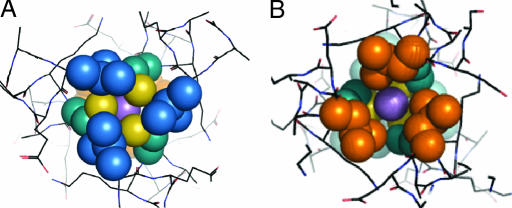Fig. 2.
The packing of the leucine layers above and below the As(III) ion, shown as a purple sphere, is illustrated. (A) Top-down view of the leucine 5 layer (blue). (B) Leu 12 layer (orange) looking up the helical axis from the C terminus; this shows the orientation of the d residues in this layer toward the helical interface. This illustrates that if a metal that prefers tetrahedral coordination such as Cd(II) or Zn(II) were coordinated to the cysteines in the same manner as As(III), the fourth exogenous ligand (e.g., water) would coordinate on the C-terminal side of the metal ion.

